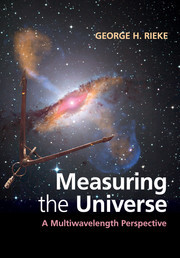Description
Measuring the Universe
A Multiwavelength Perspective
Author: Rieke George H.
A one-stop guide to astronomical instrumentation and data acquisition, with a focus on the underlying principles behind each instrument's operation.
Language: English
Subject for Measuring the Universe:
Approximative price 38.06 €
In Print (Delivery period: 14 days).
Add to cart
Measuring the Universe
Publication date: 05-2017
Support: Print on demand
Publication date: 05-2017
Support: Print on demand
Approximative price 60.02 €
In Print (Delivery period: 14 days).
Add to cart
Measuring the universe: a multiwavelength perspective
Publication date: 07-2012
352 p. · 17.8x25.3 cm · Hardback
Publication date: 07-2012
352 p. · 17.8x25.3 cm · Hardback
Description
/li>Contents
/li>Biography
/li>
Astronomy is an observational science, renewed and even revolutionized by new developments in instrumentation. With the resulting growth of multiwavelength investigation as an engine of discovery, it is increasingly important for astronomers to understand the underlying physical principles and operational characteristics for a broad range of instruments. This comprehensive text is ideal for graduate students, active researchers and instrument developers. It is a thorough review of how astronomers obtain their data, covering current approaches to astronomical measurements from radio to gamma rays. The focus is on current technology rather than the history of the field, allowing each topic to be discussed in depth. Areas covered include telescopes, detectors, photometry, spectroscopy, adaptive optics and high-contrast imaging, millimeter-wave and radio receivers, radio and optical/infrared interferometry, and X-ray and gamma-ray astronomy, all at a level that bridges the gap between the basic principles of optics and the subject's abundant specialist literature. Color versions of figures and solutions to selected problems are available online at www.cambridge.org/9780521762298.
1. Introduction; 2. Gathering light - the telescope; 3. Sensing the light: detectors for the optical and infrared; 4. Imaging and astrometry; 5. Photometry and polarimetry; 6. Spectroscopy; 7. Adaptive optics (AO) and high contrast imaging; 8. Submillimeter and radio astronomy; 9. Interferometry and aperture synthesis; 10. X-ray and gamma-ray; Index.
George H. Rieke is Regents Professor of Astronomy and Planetary Sciences at the University of Arizona, Deputy Director of Steward Observatory, and a member of the US National Academy of Sciences. Professor Rieke is Science Lead for the Mid-Infrared Instrument (MIRI) for NASA's James Webb Space Telescope and was Principal Investigator of the Multiband Imaging Photometer for Spitzer (MIPS). He has also led construction of a broad range of groundbased instruments and has taught core graduate courses on instrumentation throughout his career.
© 2024 LAVOISIER S.A.S.
These books may interest you

High Time-Resolution Astrophysics 148.73 €



